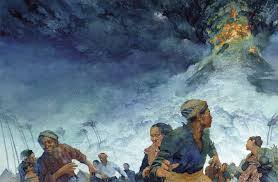
10 April 1815
The impact of Tambora explosion
The eruption of Mount Tambora in 1815 was a catastrophic natural disaster that had repercussions across the globe. An estimated 100,000 people died near the eruption itself (in present-day Indonesia) and a giant ash cloud enveloped much of the earth. Darkness lasted for months, summer turned to winter, icy blizzards struck North America and Europe in June and July, crops failed, and disease and famine spread across many parts of the world over 1815-1817. The first cholera epidemic began in India at this time, the result of Tambora related climate change, and killed tens of millions, including in Myanmar and Thailand.
In the European darkness, Mary Shelley penned "Frankenstein" and Lord Byron "The Vampyre". The exact impact on Myanmar has not been fully researched. There is some evidence that famine and disease (cholera) devastated the country, leading (perhaps) to the subsequent Konbaung invasions of Assam, Jaintia and Cachar and the deportation of large numbers of captives to the Irrawaddy valley. Yunnan suffered terribly, with crops failing entirely and famine leading to a collapse in population and the migration of survivors (not Han Chinese, but peoples indigenous to the borderlands, speaking for example Jingpo/Jingpaw, Lahu, Lisu, Wa, Tai/Dai) into what are today the Kachin and Shan states. This was the context in which Konbaung rulers pushed deeper into what is now northeast India, leading directly to the First Anglo-Burmese War of 1824.
The Smithsonian Magazine’s article on the Tambora eruption, Blast from the Past, vividly describes how the event “plunged much of the world into a frightful chill and offers lessons for today”, and is illustrated with this painting by the artist Greg Harlin of Wood Ronsaville Harlin Inc.
Explore more in Early Modern Myanmar and its Global Connections (1510-1824AD)